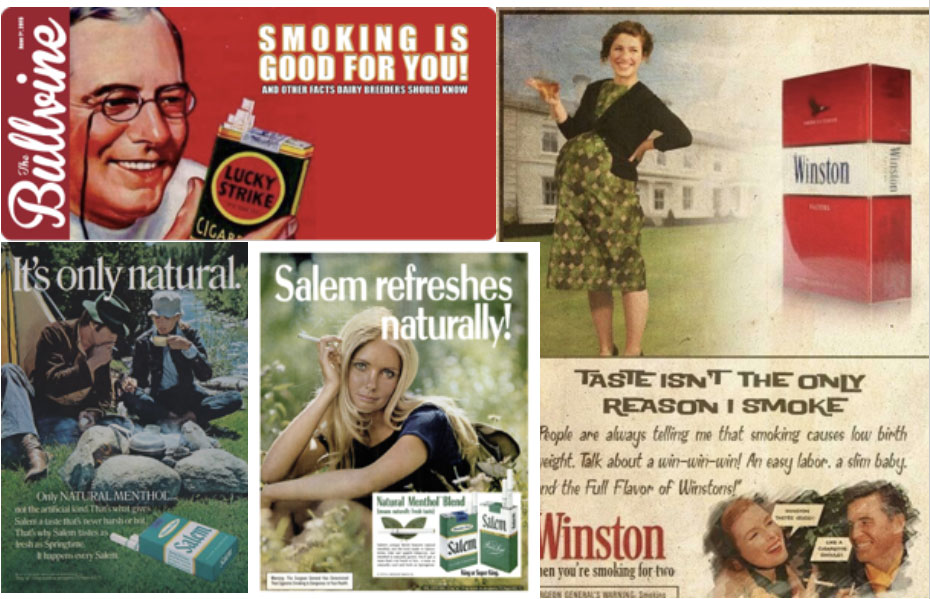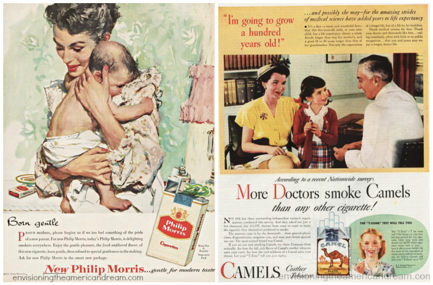
When “Natural” Isn’t Healthy
The word “natural” has a way of enticing us to feel as though we’re choosing something good for ourselves. We trust its implications and those who use it. The term has been applied to everything from food to personal care.
No question there are companies dedicated to the well-being of our bodies and our planet. But, there are also those that lean on loopholes of labeling and savvy marketing, evoking a certain emotion in order to make an unhealthy product appear healthier.
It is our responsibility – as much for our personal well-being as the well-being of the earth, to understand clearly and make empowered decisions around what is truly healthy for us and what is not.
responsibility – as much for our personal well-being as the well-being of the earth, to understand clearly and make empowered decisions around what is truly healthy for us and what is not.Take a look at these real smoking advertisements from not too long ago…

And my personal favorite… (Take a moment to read the small print.)

We may find these ads laughable now, but they were believable in the day.
The end result – a direct quote (1) from cdc.gov: “Cigarette smoking is responsible for more than 480,000 deaths per year in the United States, including more than 41,000 deaths resulting from secondhand smoke exposure. This is about one in five deaths annually, or 1,300 deaths every day. On average, smokers die 10 years earlier than nonsmokers.”
Add to that:
“Smoking leads to disease and disability and harms nearly every organ of the body. More than 16 million Americans are living with a disease caused by smoking. For every person who dies because of smoking, at least 30 people live with a serious smoking-related illness.” (2)
Really, how much sense does inhaling smoke, tar, heavy metals, and toxic chemicals directly into our lungs make? – and this is supposed to be good for us? Of course, from this perspective, the answer is obvious. Technically tobacco is natural, and advertisers focus on this aspect, but clearly this isn’t the whole truth.
Fast forward to 2018… Is it conceivable that saturating our food in pesticide – known to disrupt hormones, (1, 2, 3) damage the nervous system, (4, 5) cause aggression, (6) and cause cancer (7) – would be good for us? Is it conceivable that it’s healthy – or at the very least safe – for the land, animals, and waters of our earth to absorb and accumulate these chemicals? We have grown accustomed to trusting what we hear from advertisers, media, and even our authorities. In some cases this is a good thing, but we must be able to discern at a deeper level for ourselves.
Diverting for just a moment – some interesting questions to ponder on this topic:
- With the understanding that many of the agricultural chemicals used are known neurotoxins, could it be that the ingestion and accumulation of these may be affecting brain function and have an impact on rates of depression, anxiety, and maybe even the prevalence of violent outbursts? (6)
- With the dramatic increase in use of environmental chemicals, is it possible that some of these are flammable and may be contributing to the increase and aggression of the wildfires we are experiencing? (8, 9)
This is only the beginning of the discussion, but it’s important to begin taking an eye-opening look. Here are some areas to be aware of, to question, and where “natural” may not be healthy just because it implies as much:
FOOD
Rather than simply accepting that something is healthy because it is labeled natural – look for CERTIFIED NON-GMO and ORGANIC labels to be more secure that harmful elements are not mis-represented or confusing.For example – under the current standards, artificial “additives”, including colors are not allowed in foods labeled “natural”, BUT by FDA regulation, the standard does not address food manufacturing processes. This means that anything that happens to the food during the manufacturing process – ie. pesticide application, irradiation etc. and it still allows for the “natural” label to be used. (10)
The “natural” label also does allow antibiotics, a range of hormones, and similar chemicals under this title. The “all natural” and “natural” labels are regulated in the same way, so can be considered essentially the same.
In the case of animal products look for PASTURE RAISED and / or HUMANELY RAISED. If you shop at Whole Foods, animal products that are rated a STEP 3 or above helps to ensure that the animal was raised and treated in a healthy and humane way. This is an area that we don’t like to look, but is more important than we may realize. If you have a moment of courage, consider watching the documentary Food Inc. (11, 12)
When animals are raised in an unhealthy, stressful and even cruel manner, their natural hormones and well-being are dramatically impacted- just like ours. Besides the fact that no living being should be treated this way, hormones are natural chemical messengers. They regulate virtually every cell process in our bodies. If an animal’s stress hormones such as cortisol and adrenaline are sky high, their tissues are also saturated with that hormone. Then, we eat it. We literally feed ourselves the energy and hormone of that stressful situation. Could we be artificially elevating our own stress hormones in this way?
We should be eating to nourish ourselves and to heal our bodies by consuming whole food – nutrient-rich, toxin-free, provided by nature in its truest and pure form.
Currently, certified organic food may not contain GMO ingredients or chemical pesticides. Your financial support of farmers that are conscious of your well-being, the land, and the animals they raise is impactful.
Fun Fact: Did you know that lab grown meat / synthetic meat – meat grown artificially in a “bioreactor” and made from live animal tissue – may be on your restaurant menu as early as 2019 and will most likely be marketed “clean meat”. According to the current standards, it appears that this synthetic meat will likely not be labeled “natural” since the process requires the use of chemical preservatives to prevent the growth of fungus. (13, 14, 15, 16)
PERSONAL CARE
Many of the same principles apply to personal care products, but one area that recently caught our attention is the abundance of the word “vegan” as a positive in the world of personal care products. While this can certainly be helpful to those that are vegan by choice, it has also been used as a trend to imply healthy. What often follows is a list of a few choice chemicals that are not used – BUT what is often not mentioned is the abundance of unhealthy chemicals and additives that are still in the product. It can be a savvy way of directing attention to an area that appears healthier, but in fact may not be. For example: sulfate-free, but still contains hormone disrupting, paraben-based preservatives or toxic emulsifiers.If you are vegan or prefer vegan products, be sure to continue to read the entire ingredient list to determine the health and safety of the product. One thing to note is that most chemicals used in conventional skin care products are, by their nature, synthetic and vegan.
I recommend not stopping there. Consider spending a few moments to learn about what is in the products that you use – especially if you are applying them to your children. Children’s cells turn over faster; their immune and hormonal systems may not be fully developed, which makes them more vulnerable to the accumulation of chemicals in their body over time (bio-accumulation) and more likely to develop issues down the road. If time is a concern, take a look at www.EWG.org. The Environmental Working Group rates personal care ingredients on a scale of 0-10. We consider anything above 1, unacceptable.Also, watch out for skin care lines that do not list any preservative at all or claim to be preservative-free. If the product contains water in any form (ex. aloe juice) and doesn’t list preservative, the shelf life will be very short OR the actual preservative is there, but left off of the label. No preservative at all may mean bacterial and / or fungal growth in the product that can lead to a skin infection.